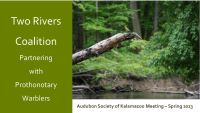Home>Our Work>Prothonotary Warbler Partnership
Prothonotary Warbler Partnership
 In 2020 we started a partnership with prothonotary warblers. It started with placing some nest boxes up along the Paw Paw River to create an easier opportunity for paddlers to see and enjoy these species of special concern in Michigan. We have led several paddling events to see these warblers and nest boxes. We are still figuring out what it takes to have them nest successfully in the nest boxes on a regular basis. While we figure this out, we have started the next phase of the partnership and need your help to collect and record sightings to help us understand where these warblers are using the watersheds.
In 2020 we started a partnership with prothonotary warblers. It started with placing some nest boxes up along the Paw Paw River to create an easier opportunity for paddlers to see and enjoy these species of special concern in Michigan. We have led several paddling events to see these warblers and nest boxes. We are still figuring out what it takes to have them nest successfully in the nest boxes on a regular basis. While we figure this out, we have started the next phase of the partnership and need your help to collect and record sightings to help us understand where these warblers are using the watersheds.
The Paw Paw and Black River Watersheds drain 4 counties over some 733 square miles. Advocating for these large watershed’s requires focused, good quality data. Community science data collected on Ebird has been able to supply this need in many ways. To help TRC monitor the health of the watersheds, the Ebird records for the Prothonotary Warbler are important. The Prothonotary Warbler is considered an indicator species of the flood plain forest and wetlands. The presence of the Prothonotary Warblers in these habitats within the watersheds provide some indication of good ecological health.
"Indicator species provide important information on habitat quality and the ecological integrity of ecosystems. Indicator species have been studied to sound the alarm when ecosystems are degraded or threatened, but they also may be used to measure the success of habitat management and conservation activities." Hoover, Jeffrey P. 2009. “Prothonotary Warblers as Indicators of Hydrological Conditions in Bottomland Forests.” In Proceedings of the Fourth International Partners in Flight Conference: Tundra to Tropics, edited by Terrell D. Rich, Coro Arizmendi, Dean W. Demarest, and Craig Thompson, 128–137. Partners in Flight.
We encourage the community to help us add to this Ebird dataset and fill in the gaps in our watershed where the Prothonotary Warblers are found and maybe nesting. Log onto Ebird and explore their abundance maps which show sightings by community members. Find a blank spot on the map where the river runs and see if you can go there and make observations of these warblers. Maybe there is a park nearby or a bridge crossing the river. Respect private property.
Alternatively, you can use the map above which shows yellow or orange (if surveyed recently) waypoints with stars at some of the key bridges and parks along the river. There are 15 waypoints (yellow with star) on the Black River and 10 for the Paw Paw River. These are sites along the rivers that we lack data on and could use some help seeing if prothonotary warblers are in these areas. Record your sightings on Ebird so we can know that these warblers are found there. If you have no sightings of prothonotary warblers, send us an email at healthywatersheds@tworiverscoalition.org and let us know what you found and where you visited. The map also shows the location of our nest boxes (houses) and eBird sightings location records: gray bird icon= 2022, yellow bird icon= 2023 and green bird icon= 2024!
Details for the June Paddle Trip to see Prothonotary Warblers:
TRC’s Prothonotary Warblers Paddle on the Paw Paw River
Date: About the 2nd or 3rd weekend in June - check our list of events or calendar for more details
Launch / Put in: Paw Paw Michigan’s Maple Lake Dam Access (42.235546, -85.886401), Google Maps
Arrive 9:30 AM to prepare for a 10:00 AM launch
Take Out: Route 665 Bridge (42.256302, -85.906915), Google Maps
Distance and estimated Paddle Time: 2.6 miles in 3 hours (4 if we really find lots of warblers), expect to arrive at take by 2PM at the latest.
Join TRC as we paddle the Paw Paw River to enjoy some time on the river while also looking for prothonotary warblers. TRC has installed several nest boxes on the river to help this floodplain forest indicator species. These beautiful warblers are helping us understand the health of our floodplain forest along the Paw Paw River. This section of the river is rated as beginner but with the low water conditions may pose some challenges. A personal floatation device (PFD) is required for everyone’s safety.
Thanks for your help!!


